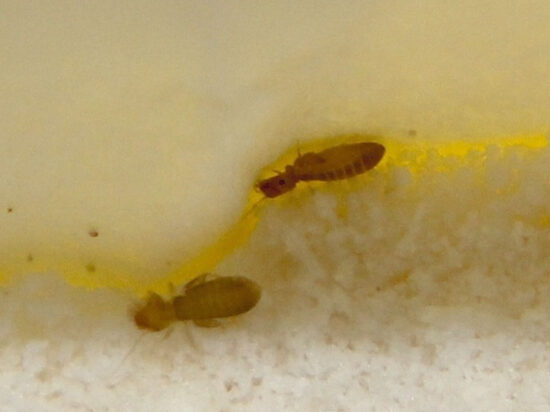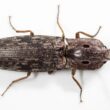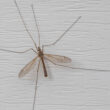Finding tiny bugs crawling around your books or walls can be pretty unsettling. If you’ve spotted small, fast-moving insects that look like tiny specks, you might be dealing with booklice. The good news? Learning how to get rid of booklice doesn’t have to be complicated.
Booklice aren’t actually lice at all. These tiny insects, also called psocids, are harmless creatures that won’t bite you or spread diseases. But they can be annoying when they show up in large numbers. They love warm, humid places where mold and mildew grow because that’s what they eat.
Getting rid of booklice requires tackling the conditions that attract them in the first place. Most of the time, that means controlling moisture and eliminating their food sources. Here are 12 proven methods that will help you eliminate these pesky little bugs and keep them from coming back.
1. Control Humidity Levels in Your Home
The most important step in getting rid of booklice is controlling the humidity in your home. These bugs need moisture to survive, and they’ll die off quickly when conditions get too dry for them.
Keep your home’s humidity below 50%. The ideal range is between 30% and 50%. You can buy an inexpensive humidity meter at most hardware stores to monitor levels throughout your house.
Use dehumidifiers in problem areas like basements, bathrooms, and any rooms where you’ve seen booklice. Run your air conditioning and turn on fans to keep air moving. Good air circulation helps prevent the damp conditions booklice love.
Open windows regularly to let fresh air in, especially in bathrooms and kitchens where steam builds up. Make sure your bathroom and kitchen exhaust fans work properly and use them every time you shower or cook.
In just a few weeks of keeping humidity low, you should notice fewer booklice. They simply can’t survive in dry conditions.
2. Get Rid of Mold and Mildew
Booklice feed on mold and mildew, so removing these food sources is key to getting rid of booklice permanently. Look for any signs of mold growth in your home and clean it up right away.
Make a cleaning solution by mixing 200ml of bleach with 100ml of multipurpose cleaner and 1000ml of water. Use this to scrub moldy areas, but make sure the room is well ventilated when you work with bleach.
For a natural approach, try mixing one cup of borax with one gallon of warm water. You can also use white vinegar or 3% hydrogen peroxide, which work well on books and leather items without leaving harsh chemical smells.
Remove any items that are heavily moldy, like old wallpaper, cardboard boxes, or books with visible mold growth. Sometimes it’s better to throw these things away rather than try to clean them.
Fix the root causes of mold growth by repairing leaks, improving ventilation, and keeping areas dry. Mold will just come back if you don’t address what’s causing the moisture problem in the first place.
3. Clean and Vacuum Everything Thoroughly
A good deep cleaning can remove both booklice and their eggs from your home. Use a vacuum with a HEPA filter to suck up the tiny bugs and any mold spores they might be feeding on.
Pay special attention to cracks, crevices, baseboards, and corners where booklice like to hide. Vacuum around bookshelves, furniture, and any storage areas where you’ve seen the bugs.
Clean all surfaces with a damp cloth and mild soap. Wipe down bookshelves, window sills, and other areas where moisture might collect. Regular cleaning prevents mold spores from building up and gives booklice fewer places to feed.
Always dispose of vacuum cleaner contents outside your home right after cleaning. Put the vacuum bag or empty the canister into an outdoor trash bin to make sure you don’t accidentally release any live bugs back into your house.
Keep up with regular cleaning to prevent future problems. A weekly vacuum and wipe-down of problem areas goes a long way toward preventing booklice from coming back.
4. Use Diatomaceous Earth
- Kills fleas, ants, roaches, and more
- Includes powder duster for easy, targeted application
- Works indoors and outdoors, long-lasting when dry
- 100% pure, food-grade, safe around pets and kids
Diatomaceous earth is a natural powder that can help eliminate booklice by drying them out. This fine powder is made from fossilized algae and works by sticking to the bugs and causing tiny cuts in their outer shell.
Buy food-grade diatomaceous earth from a hardware store or online. Sprinkle a light, even layer along baseboards, in cracks and crevices, and anywhere you’ve seen booklice activity.
The powder works best when it stays dry, so apply it to areas that don’t get wet. If the powder gets damp, it won’t work as well and you’ll need to reapply it.
Use a dust mask when applying diatomaceous earth because breathing in the fine powder can irritate your lungs. Keep it away from children and pets, even though the food-grade version is generally safe.
Be patient with this method. It can take about two weeks to see full results as the booklice come into contact with the powder over time.
5. Try Temperature Treatments
Booklice can’t survive extreme temperatures, so you can use both heat and cold to eliminate them from books and other items.
For the freezing method, seal infested books, papers, or other small items in plastic bags and put them in your freezer for at least 24 to 48 hours. This kills both adult booklice and their eggs.
When you take items out of the freezer, let them warm up to room temperature slowly while still in the sealed bags. This prevents condensation from forming and causing new mold growth.
For heat treatment, you can expose items to temperatures above 120°F for several hours. A hair dryer can work for small areas, but be careful not to damage delicate papers or book bindings.
Professional heat treatments are available for severe infestations. These use specialized equipment to heat entire rooms to temperatures that kill booklice without damaging your belongings.
6. Remove Heavily Infested Items
Sometimes the best solution is to throw away items that are too heavily infested to save. This might seem drastic, but getting rid of booklice often requires removing their breeding grounds completely.
Look through your books, papers, and storage materials for signs of heavy mold growth or large numbers of booklice. Items with visible mold damage or that feel damp should probably be discarded.
Pay special attention to cardboard boxes, old magazines, and papers stored in damp areas. These materials break down easily in humid conditions and become perfect breeding spots for both mold and booklice.
If you’re not sure whether to keep something, move it to a dry, well-ventilated area away from other items while you decide. This prevents the problem from spreading while you figure out your next step.
Focus your efforts on saving items that are truly valuable or irreplaceable. For everything else, it’s often easier and more effective to start fresh with new, uninfested materials.
7. Make Natural Essential Oil Sprays
- Plant-based peppermint oil formula repels pests naturally
- Safe to use around pets, kids, and indoor living spaces
- Great for garages, attics, baseboards, and outdoor areas
- Fresh mint scent with long-lasting protection
Essential oils can help repel booklice and make your home less attractive to these moisture-loving bugs. Several oils have natural insect-repelling properties that work well against booklice.
Mix a few drops of tea tree oil, lavender oil, peppermint oil, or eucalyptus oil with water in a spray bottle. Use about 10-15 drops of oil per cup of water. Shake well before each use.
Spray this mixture on areas where you’ve seen booklice, but test it on a small, hidden area first to make sure it won’t stain or damage surfaces. Avoid spraying directly on valuable books or papers.
Neem oil is another natural option that you can buy pre-mixed in commercial products. This oil has been used for centuries as a natural pest deterrent and works well against many household bugs.
Reapply these natural sprays regularly since they don’t last as long as chemical treatments. The pleasant smell is a nice bonus compared to harsh chemical pesticides.
8. Use Chemical Treatments When Needed
If natural methods aren’t working fast enough, you might need to use insecticides specifically designed for booklice. These should be your backup plan after trying gentler approaches first.
Look for products labeled specifically for booklice or psocids. Pyrid Aerosol is one option that many pest control professionals recommend for light misting on bookshelves and furniture.
Apply residual insecticides in cracks, crevices, and other hiding spots where booklice gather. Follow the manufacturer’s instructions exactly and wear protective gear like gloves and a mask.
Never spray insecticides near food, in food preparation areas, or in spaces where children and pets spend lots of time. These chemicals can be harmful if not used properly.
Remember that chemical treatments won’t work long-term if you don’t also control humidity and eliminate mold. The booklice will just come back if the conditions that attract them are still there.
9. Seal Up Entry Points and Improve Storage
Preventing booklice from getting into your home in the first place makes getting rid of booklice much easier. Look for gaps and cracks where these tiny bugs might be entering.
Use caulk to seal cracks around windows, doors, and baseboards. Install weatherstripping around doors and windows to keep moisture out as well as bugs.
Replace cardboard storage boxes with airtight plastic containers. Cardboard absorbs moisture and can develop mold, creating perfect conditions for booklice to thrive.
Store books, papers, and other susceptible items in dry, well-ventilated areas. Avoid basements and attics where humidity levels tend to be higher.
Add silica gel packets to storage containers to absorb extra moisture. You can buy these packets at craft stores or reuse the ones that come in shoe boxes and electronic packaging.
10. Fix All Moisture Problems
Getting rid of booklice for good means fixing every source of excess moisture in your home. These bugs will keep coming back as long as you have water problems.
Check for and repair any leaks in your plumbing, roof, or windows. Even small leaks can create enough moisture to support booklice populations.
Look for condensation problems around appliances like air conditioners, refrigerators, and water heaters. Insulate pipes that sweat and make sure appliances drain properly.
Improve drainage around your home’s foundation to prevent water from seeping into basements and crawl spaces. Clean gutters regularly so water flows away from your house.
Install proper ventilation in areas that naturally have high humidity, like bathrooms, kitchens, basements, and attics. Good airflow prevents moisture from building up.
11. Consider Professional Treatment Options
For severe infestations or when DIY methods aren’t working, professional pest control can provide more powerful solutions for getting rid of booklice.
Professional misting treatments can reach areas that are hard to treat yourself, like inside walls or high ceilings. Trained technicians have specialized equipment and stronger products than what’s available to homeowners.
Heat treatments performed by professionals can eliminate booklice from entire rooms or buildings. These treatments use precise temperature control to kill bugs without damaging your belongings.
Pest control companies can also provide comprehensive moisture management plans. They’ll identify all the factors contributing to your booklice problem and help you fix them.
Many professionals guarantee their work and will return for follow-up treatments if needed. This can be worth the cost when you’re dealing with persistent infestations.
12. Set Up Long-Term Prevention
Once you’ve eliminated your booklice problem, keeping them from coming back requires ongoing attention to moisture control and cleanliness.
Create a regular cleaning schedule that includes vacuuming and wiping down areas where booklice might return. Weekly cleaning of problem areas helps catch new issues before they become major infestations.
Monitor humidity levels year-round, not just during the initial treatment period. Seasonal changes, new leaks, or ventilation problems can create conditions that attract booklice again.
Inspect any new books, papers, or cardboard items before bringing them into your home. Some people freeze new books for a few days as a precaution, especially if they’re buying used books from humid storage areas.
Keep up with mold prevention by maintaining good ventilation, fixing leaks promptly, and cleaning up any moisture problems right away.
Schedule periodic professional inspections if you’ve had serious booklice problems in the past. Catching new issues early makes them much easier to handle.




